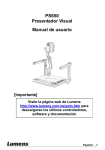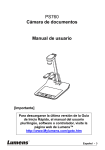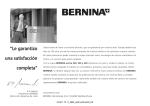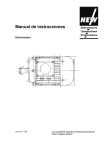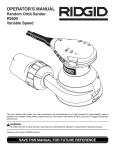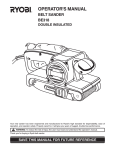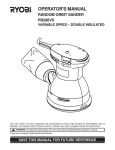Download Benchtop BENCHTOP BT300 Owner`s manual
Transcript
607691-00/BT300 Sander 11/3/03 3:14 PM Page 1 OWNER'S MANUAL 5 in. (127 MM) Palm Grip Random Orbit Sander MODEL NO. BT300 Save this manual for future reference CAUTION: Read, understand and follow all safety rules and instructions before using this tool. SOLD BY: Kmart Corporation Troy, Michigan 48084 Form No. 607691-00 Cat. No. BT300 Printed in U.S.A. OCT-01-CD-1 607691-00/BT300 Sander 11/3/03 3:14 PM Page 2 TABLE OF CONTENTS • Warranty / Introduction / Tool Specifications ..............................................................................2 • General Safety Rules ..............................................................................................................3-5 • Safety Warnings ......................................................................................................................5-7 • Assembly / Set-Up ......................................................................................................................7 • Operating Instructions ................................................................................................................8 • Maintenance ..............................................................................................................................8 WARRANTY FULL 2 YEAR WARRANTY ON BENCHTOP® 5 in. Random Orbit Sander If this BENCHTOP® 5 in. Random Orbit Sander is found to be defective in materials or workmanship within 2 years from the date of purchase, Kmart will replace the tool, free of charge. WARRANTY REPLACEMENT IS AVAILABLE BY RETURNING THE TOOL TO THE NEAREST KMART STORE ALONG WITH RECEIPT SHOWING DATE OF PURCHASE. This warranty does not include damage/defects caused by or resulting from abuse, accidents, alterations or commercial use. It also does not cover accessories. This warranty does give you specific legal rights, and you may also have other rights which vary from state to state. Kmart Corporation, 3100 Big Beaver Road, Troy, Michigan 48084 For repair / replacement parts after warranty has expired, call: 1-800-544-6986 INTRODUCTION Your Sander has many features that will make your job faster and easier. Safety, performance and dependability have been given top priority in the design of this tool, making it easy to maintain and operate. CAUTION: Carefully read through the entire manual before attempting to use this tool. Be sure to pay special attention to the Warnings and Cautions on pages 6 and 7 in this manual. If you use the tool properly and only for the operations for which it was intended, you can enjoy years of safe, dependable service from it. 2 Made in U.S.A 607691-00/BT300 Sander 11/3/03 3:14 PM Page 3 GENERAL SAFETY RULES (FOR ALL TOOLS) The purpose of safety symbols is to immediately attract your attention to the possibility of danger. The following safety symbols and the explanations of them deserve your careful attention and complete understanding. These safety warnings do not eliminate any dangers on their own, and the instructions and warnings they give should not be taken as substitutes for proper accident prevention measures. SYMBOL MEANING WARNING: Do not attempt to operate this tool until you have thoroughly read and fully understand all the Safety Rules, Rules For Safe Operation, and Instructions and Information specific to the safe operation of this tool. Failure to do so can result in accidents involving serious personal injury, fire or electric shock. Save this manual and review it frequently for safe operation and for instructing others on the proper use of this tool. SAFETY ALERT SYMBOL Indicates caution or warning. May be used in conjunction with other symbols or pictures/graphs. WARNING CAUTION NOTE Failure to heed a safety WARNING can result in serious injury to yourself or to others. Always follow the safety precautions to reduce the risk of fire, electric shock and personal injury. WARNING: Do not attempt to operate tool if any parts are missing. Failure to do so could result in possible serious personal injury. Do not use tool if trigger switch does not turn it on or off. Failure to heed a safety CAUTION can result in property damage or personal injury to yourself or to others. Always follow the safety precautions to reduce the risk of fire, electric shock and personal injury. WARNING: Do not allow familiarity with the tool to make you careless in its operation. Remember that it only takes a careless fraction of a second to inflict severe injury. Advises you of information or instructions that are necessary in the operation and maintenance of the tool. 3 607691-00/BT300 Sander 11/3/03 3:14 PM Page 4 GENERAL SAFETY RULES (FOR ALL TOOLS) • USE SAFETY GLASSES AND OTHER • KNOW YOUR POWER TOOL. Read this • • • • • • • • owner's manual carefully. Learn your tool's applications and limitations, as well as the possible hazards related to it. KEEP WORK AREA CLEAN. Cluttered areas and benches invite injuries. CONSIDER WORK AREA ENVIRONMENT. •Don’t expose power tools to rain. •Don’t use power tools in damp or wet locations. •Keep work area well lit. •Do not use in presence of flammable liquids or gases. Motors in these tools normally spark, and the sparks may ignite the fumes. GUARD AGAINST ELECTRIC SHOCK. Prevent body contact with grounded surfaces. For example; pipes, radiators, ranges, refrigerator enclosures. Use extreme caution when drilling, driving, or cutting into walls, floors, ceilings or other areas or wherever live electrical wires may be contacted, do not touch any metal parts of the tool. Hold the tools only by the plastic handle to prevent electric shock. KEEP CHILDREN AWAY. Do not let children and visitors contact tool or extension cord. All children and visitors should be kept away from work area. STORE IDLE TOOLS. When not in use, tools should be stored in dry, and high or locked-up place–out of reach of children. DON’T FORCE TOOL. It will do the job better and safer at the rate for which it was intended. USE RIGHT TOOL. Don’t force small tool or attachment to do the job of a heavy-duty tool. Don’t use tool for purposes not intended. DRESS PROPERLY. Do not wear loose clothing or jewelry. They can be caught in moving parts. Rubber gloves and non-skid footwear are recommended when working outdoors. Wear protective hair covering to contain long hair. • • • • • • • • SAFETY EQUIPMENT. Use safety goggles or safety glasses with side shields, complying with applicable safety standards and, when needed, a face shield. Also use face or dust mask if cutting operation is dusty. This applies to all persons in the work area. Also use a hard hat, hearing protection, gloves, safety shoes and dust collection systems when specified or required. DON’T ABUSE CORD. Never carry tool by cord or yank it to disconnect from receptacle. Keep cord from heat, oil, and sharp edges. SECURE WORK. Use clamps or a vise to hold work. It’s safer than using your hand and it frees both hands to operate tool. DON’T OVERREACH. Keep proper footing and balance at all times. MAINTAIN TOOLS WITH CARE. Keep tools sharp and clean for better and safer performance. Follow instructions for lubricating and changing accessories. Inspect tool cords periodically and replace if damaged. Inspect extension cords periodically and replace if damaged. Keep handles dry, clean, and free from oil and grease. DISCONNECT TOOLS. Unplug the tool when not in use, when moving tool from place to place, before servicing, and when changing accessories (such as blades, bits, cutters) or making adjustments. REMOVE ADJUSTING KEYS AND WRENCHES. Form habit of checking to see that keys and adjusting wrenches are removed from tool before turning it on. AVOID UNINTENTIONAL STARTING. Don’t carry tool with finger on switch. Be sure switch is off when plugging in. EXTENSION CORDS. Make sure your extension cord is in good condition. When using an extension cord, be sure to use one heavy enough to carry the current your product will draw. An undersized cord will IMPORTANT! READ ALL INSTRUCTIONS! 4 607691-00/BT300 Sander 11/3/03 3:14 PM Page 5 GENERAL SAFETY RULES (FOR ALL TOOLS) cause a drop in line voltage resulting in loss of power and overheating. The following table shows the correct size to use depending on cord length and nameplate ampere rating. If in doubt, use the next heavier gage. The smaller the gage number, the heavier the cord. • OUTDOOR USE EXTENSION CORDS. When tool is used outdoors, use only extension cords intended for use outdoors and so marked. • STAY ALERT. Watch what you are doing. Use common sense. DO NOT OPERATE TOOL when you are tired or otherwise impaired. • CHECK DAMAGED PARTS. Before using the tool, during and after the operation of tool, always check carefully for damaged parts, the alignment of moving parts, breakage of parts, mounting, and any other conditions that may affect its safe operation. If a guard or any other part is damaged, return the tool to your local Kmart for a free replacement (applies for duration of warranty, see WARRANTY section at the front of this manual). • USE OF ACCESSORIES AND ATTACHMENTS. The use of any accessory or attachment not recommended for use with the tool could be hazardous. Minimum Gage for Cord Sets Volts Total Length of Cord in Feet 120V 0-25 26-50 51-100 101-150 240V 0-50 51-100 101-200 201-300 Ampere Rating More Not more AWG Than Than 0 6 10 12 - 6 10 12 16 18 18 16 14 16 16 16 12 16 14 14 12 14 12 Not Recommended SAFETY WARNINGS AND INSTRUCTIONS: DOUBLE INSULATION Double insulated tools are constructed throughout with two separate layers of electrical insulation or a double thickness of insulation between you and the tool’s electrical system. Tools built with double insulation are not intended to be grounded. As a result, your tool is equipped with a two prong plug which permits you to use extension cords without concern for maintaining a ground connection. Double insulation does not take the place of normal safety precautions when operating this tool. The insulation system is for added protection against injury resulting from a possible electrical insulation failure within the tool. The insulation system is for added protection against injury resulting from a possible electrical insulation failure within the tool. WARNING: The operation of any power tool can result in foreign objects being thrown into your eyes, which can result in severe eye damage. Before beginning power tool operation, we recommend wearing safety goggles or safety glasses with side shield and a full face shield, if needed. 5 607691-00/BT300 Sander 11/3/03 3:14 PM Page 6 SAFETY WARNINGS AND INSTRUCTIONS: POLARIZED PLUGS Polarized plugs (one blade is wider than the other) are used on equipment to reduce the risk of electric shock. When provided, this plug will fit into a polarized outlet only one way. If the plug does not fit fully into the outlet, reverse the plug. If it still does not fit, contact a qualified electrician to install the proper outlet. Do not change the plug in any way. SAFETY WARNINGS AND INSTRUCTIONS: SANDERS WARNING: Some dust created by power sanding, sawing, grinding, drilling, and other construction activities contains chemicals known to cause cancer, birth defects or other reproductive harm. Some examples of these chemicals are: • lead from lead-based paints, • crystalline silica from bricks and cement and other masonry products, and • arsenic and chromium from chemically-treated lumber. (CCA) Your risk from these exposures varies, depending on how often you do this type of work. To reduce your exposure to these chemicals: work in a well ventilated area, and work with approved safety equipment, such as those dust masks that are specially designed to filter out microscopic particles.. • ALWAYS WEAR EYE PROTECTION. • Clean your tool out periodically. CAUTION: If you are using your sander as a random orbit polisher and elect to use draw string bonnets, be sure to tuck loose ends of the string securely under the bonnet after tying the knot. Failure to do so may cause serious injury. Check often to assure string ends remain tucked under bonnet. OTHER IMPORTANT SAFETY WARNINGS AND INSTRUCTIONS Sanding of lead based paint is NOT RECOMMENDED due to the difficulty of controlling the contaminated dust. The greatest danger of lead poisoning is to children and pregnant women. Since it is difficult to identify whether or not a paint contains lead without a chemical analysis, we recommend the following precautions when sanding any paint: • PERSONAL SAFETY • No children or pregnant women should enter the work area where the paint sanding is being done until all clean up is completed. • A dust mask or respirator should be worn by all persons entering the work area. The filter should be replaced daily or whenever the wearer has difficulty breathing. IMPORTANT! READ ALL INSTRUCTIONS! 6 607691-00/BT300 Sander 11/3/03 3:14 PM NOTE: Only those dust masks suitable for working with lead paint dust and fumes should be used. Ordinary painting masks do not offer this protection. See your local hardware dealer for the proper (NIOSH approved) mask. • NO EATING, DRINKING or SMOKING should be done in the work area to prevent ingesting contaminated paint particles. Workers should wash and clean up BEFORE eating, drinking or smoking. Articles of food, drink, or smoking should not be left in the work area where dust would settle on them. • ENVIRONMENTAL SAFETY • Paint should be removed in such a manner as to minimize the amount of dust generated. • Areas where paint removal is occurring should be sealed with plastic sheeting of 4 mils thickness. • Sanding should be done in a manner to Page 7 reduce tracking of paint dust outside the work area. • CLEANING AND DISPOSAL • All surfaces in the work area should be vacuumed and thoroughly cleaned daily for the duration of the sanding project. Vacuum filter bags should be changed frequently. • Plastic drop cloths should be gathered up and disposed of along with any dust chips or other removal debris. They should be placed in sealed refuse receptacles and disposed of through regular trash pick-up procedures. During clean up, children and pregnant women should be kept away from the immediate work area. • All toys, washable furniture and utensils used by children should be washed thoroughly before being used again. SAVE THESE INSTRUCTIONS ASSEMBLY / ADJUSTMENT SET-UP WARNING: Always unplug tool from power supply before any of the following operations. center it over the sanding pad ensuring that the holes in the disc align with the holes in the pad and press the disc firmly in place. The hook and loop fastening system sanding disc can be easily removed by simply pulling it off. It can be reused as desired. MOTOR Be sure your power supply agrees with nameplate marking. 120 Volts AC only means your tool will operate on standard 60 Hz household power. Do not operate AC tools on DC. A rating of 120 volts AC/DC means that your tool will operate on standard 60 Hz AC or DC power. This information is printed on the nameplate. Lower voltage will cause loss of power and can result in over-heating. All BENCHTOP® tools are factory-tested; if this tool does not operate, check the power supply. ATTACHING HOOK AND LOOP SANDING DISCS Your sander is designed to use 5” (127mm) sanding discs with the 8 hole dust extraction pattern. To attach the sanding disc, carefully IMPORTANT! READ ALL INSTRUCTIONS! 7 607691-00/BT300 Sander 11/3/03 3:14 PM Page 8 OPERATING INSTRUCTIONS DUST COLLECTION WARNING: To reduce the risk of WARNING: Collected sanding dust from sanding surface coatings (polyurethane, linseed oil, etc.) can selfignite in sander dust bag or elsewhere and cause fire. To reduce risk, empty bag frequently and strictly follow sander manual and coating manufacturer's instructions. Your sander comes equipped with a cloth canister to collect the dust generated while sanding. To attached the canister to the sander, fit it firmly onto the dust extraction port at the back of the sander. To empty the canister, remove it from the dust port and dump the sanding debris into an appropriate trash receptacle. You may, if you prefer, attach a vacuum cleaner to the tool to collect the dust as you sand. Simply remove the dust bag and install the vacuum hose over or into the dust extraction port. Shop vacuums come with two diameters of hoses and the dust extraction port is designed to accept both of them. Ensure that the vacuum cleaner can be placed such that it will not tip over or interfere with the motion of the sander. If this cannot be done, do not use the vacuum cleaner. Turn on the vacuum cleaner before beginning to sand and turn it off after turning off the sander. Empty vacuum cleaner as required. serious personal injury, read, understand and follow all important safety warnings and instructions prior to using this tool. SWITCH To turn the tool ON, hold it as shown in Fig. 1 and push the portion of the switch marked"I" for low speed and the portion marked “II” for high speed. The center position marked "O" is OFF. NOTE: Always return the switch to the "OFF" position before changing operating speed. Use the high speed for fast material removal and the low speed for a finer finish. FIG. 1 ON OFF SWITCH OPERATION Grasp the sander as shown and turn it ON. Move it in long, sweeping strokes along the surface, letting it do the work. Pushing down on the tool while sanding actually slows the removal rate and produces an inferior quality finish. Check your work often. This sander is capable of removing material rapidly. MAINTENANCE Use only mild soap and damp cloth to clean the tool. Never let any liquid get inside the tool; never immerse any part of the tool into a liquid. 8 607691-00/BT300 Sander 11/3/03 3:14 PM 9 Page 9 607691-00/BT300 Sander 11/3/03 3:14 PM 10 Page 10 607691-00/BT300 Sander 11/3/03 3:14 PM Page 1 MANUAL DEL PROPIETARIO Lijadora de órbita variable de 127 mm (5") MODELO NO. BT300 Conserve este manual para referencias futuras PRECAUCIÓN: Lea, comprenda y siga todas las reglas e instrucciones de seguridad antes de usar esta herramienta. VENDIDO POR Kmart Corporation Troy, Michigan 48084 607691-00/BT300 Sander 11/3/03 3:14 PM Page 2 CONTENIDO • Garantía / Introducción / Especificaciones ................................................................................2 • Reglas generales de seguridad ..............................................................................................3-5 • Advertencias de seguridad......................................................................................................6-7 • Ensamblaje / Ajustes iniciales ................................................................................................8-9 • Instrucciones de operación ........................................................................................................8 • Mantenimiento ............................................................................................................................9 GARANTÍA GARANTÍA COMPLETA POR 2 AÑOS en la Lijadora de órbita variable BENCHTOP® de 127 mm (5") Si esta lijadora BENCHTOP® de 127 mm (5") resultase con defectos en los materiales o mano de obra dentro de los 2 años siguientes a la fecha de compra, Kmart reemplazará la herramienta, libre de cargo. EL CAMBIO EN GARANTÍA ESTÁ DISPONIBLE DEVOLVIENDO LA HERRAMIENTA A LA TIENDA KMART MÁS CERCANA JUNTO CON EL RECIBO QUE MUESTRE LA FECHA DE COMPRA. Esta garantía no cubre daños/defectos causados o resultantes de abuso, accidentes, alteraciones o uso comercial. Tampoco cubre los accesorios. Esta garantía le otorga derechos específicos, y usted puede tener otros derechos que varían de estado a estado. Kmart Corporation, 3100 Big Beaver Road, Troy, Michigan 48084 Para reparaciones o refacciones después de que la garantía haya expirado, llame al: 1-800-544-6986 INTRODUCCIÓN Su lijadora tiene varias características que ayudarán a hacer su trabajo de manera más rápida y más sencilla. Seguridad, rendimiento y confiabilidad han sido la máxima prioridad en el diseño de esta herramienta, haciendo de ella una pieza de fácil mantenimiento y operación. PRECAUCIÓN: Lea cuidadosamente el ma- ESPECIFICACIONES Tamaño de la almohadilla Órbitas por minuto Tensión de alimentación Consumo de corriente nual completo antes de intentar usar esta herramienta. Asegúrese de prestar especial atención a las “Advertencias y Precauciones” que se encuentran en las pàginas 6 y 7 de este manual. Si utiliza la herPotencia nominal: ramienta apropiadamente y solamente para las operaFrecuencia de operación: ciones para las que se diseñó, podrá disfrutar de años Consumo de corriente: de servicio seguro y confiable. 2 127 mm (5") 12,000 OPM 120 V~ 2A 192.0 W 60 Hz 2,0 A 607691-00/BT300 Sander 11/3/03 3:15 PM Page 3 REGLAS GENERALES DE SEGURIDAD (PARA TODAS LAS HERRAMIENTAS) El propósito de los símbolos de seguridad es atraer su atención inmediatamente a los posibles daños. Los siguientes símbolos de seguridad y sus explicaciones merecen su atención cuidadosa y entendimiento completo. Estas advertencias de seguridad no eliminan ningún peligro por sí mismas, y las instrucciones y advertencias no deben tomarse como sustitutos de las medidas de prevención de accidentes apropiadas. SÍMBOLO SIGNIFICADO SÍMBOLO DE ALERTA DE SEGURIDAD Indica precaución o advertencia. Puede utilizarse junto con otros símbolos o pictogramas. ADVERTENCIA PRECAUCIÓN NOTA Hacer caso omiso de una ADVERTENCIA de seguridad puede ocasionarle lesiones graves a usted o a otras personas. Siga siempre las precauciones de seguridad para reducir el riesgo de incendio, choque eléctrico y lesiones personales. Hacer caso omiso de una PRECAUCIÓN de seguridad puede resultar en daños a sus propiedades o lesiones personales a usted o a otras personas. Siga siempre las precauciones de seguridad para reducir el riesgo de incendio, choque eléctrico y lesiones personales. Le avisa de información o instrucciones que son necesarias para la operación y mantenimiento de la herramienta. 3 ADVERTENCIA: No intente operar esta herramienta hasta haber leído y comprendido completamente todas las Reglas de seguridad, Reglas para la operación segura, e Instrucciones e Información específica para la operación segura de esta herramienta. No hacerlo puede resultar en accidentes que involucren lesiones personales graves, incendios o choques eléctricos. Conserve este manual y revíselo con frecuencia para operar la herramienta de manera segura y para instruir a otras personas en el uso correcto de esta herramienta. ADVERTENCIA: No intente operar la herramienta si falta cualquier parte. Hacerlo podría ocasionar una lesión personal de gravedad. No use la herramienta si el interruptor no enciende y apaga. ADVERTENCIA: No permita que el familiarizarse con la herramienta le haga perder cuidado en la operación. Recuerde que sólo toma una fracción de segundo descuidarse y provocar una lesión grave. 607691-00/BT300 Sander 11/3/03 3:15 PM Page 4 REGLAS GENERALES DE SEGURIDAD (PARA TODAS LAS HERRAMIENTAS) • CONOZCA SU HERRAMIENTA. Lea • NO FUERCE LA HERRAMIENTA. Esta hará cuidadosamente este manual del propietario. Aprenda las aplicaciones y limitaciones de su herramienta, así como los peligros relacionados con ella. CONSERVE LIMPIA EL ÁREA DE TRABAJO. las zonas y los bancos con objetos acumulados en desorden propician los accidentes. DE PRIORIDAD AL ÁREA DE TRABAJO. • No exponga las herramientas eléctricas a la lluvia. • No use herramienta eléctricas en lugares inundados o mojados. • Conserve el área de trabajo bien iluminada. • No se use en presencia de líquidos o gases inflamables, Los motores de estas herramientas producen chispas en condiciones normales, y estas chispas pueden originar la ignición de los vapores. PROTÉJASE CONTRA EL CHOQUE ELÉCTRICO. Evite el contacto corporal con superficies aterrizadas, por ejemplo: tuberías radiadores, hornos, gabinetes de refrigeración, etc. Tenga precaución extrema cuando taladre, atornille o corte en muros, pisos, techos u otras áreas en que pueda hacer contacto con cables eléctricos vivos, no toque ninguna parte metálica de la herramienta. Sujete las herramientas únicamente por las empuñaduras de plástico para evitar el choque eléctrico. CONSERVE APARTADOS A LOS NIÑOS. No permita que niños ni otros visitantes toquen la herramienta ni los cables de extensión. Todos los niños y visitantes deben apartarse del área de trabajo. GUARDE LAS HERRAMIENTAS QUE NO EMPLEE. Siempre que no use las herramientas, debe guardarlas en un lugar seco y elevado o bajo llave, fuera del alcance de los niños. el trabajo mejor y de manera más segura bajo las especificaciones para las que se diseñó. EMPLEE LA HERRAMIENTA ADECUADA. No fuerce a una herramienta pequeña o a sus dispositivos en una tarea destinada a una herramienta de alto rendimiento. No utilice la herramienta para tareas para las que no ha sido diseñada. VÍSTASE DE MANERA ADECUADA. No utilice ropas sueltas ni joyas, pueden quedar atrapadas en las partes móviles. Se recomienda el uso de guantes y calzado antiderrapante cuando trabaje a la intemperie. Cúbrase el cabello si lo tiene largo. UTILICE GAFAS Y OTRO EQUIPO DE SEGURIDAD. Utilice gafas o anteojos de seguridad con cubiertas laterales, que cumplan con los estándares de seguridad aplicables y, cuando se requiera, una careta. Utilice también una mascarilla contra polvo si la operación lo produce. Esto se aplica a todas las personas que se encuentren en el área de trabajo. Utilice también casco, protección para los oídos, guantes, calzado de seguridad y sistemas de recolección de polvo cuando se especifique o así se requiera. NO MALTRATE EL CABLE. Nunca cargue la herramienta por el cable ni tire de éste para desconectarlo de la toma de corrien-te. Aléjelo de calor, aceite y bordes afilados ASEGURE LAS PIEZAS DE TRABAJO. Utilice prensas para sujetar su pieza de trabajo; es más seguro que usar su mano y le deja ambas manos libres para operar la herramienta. NO SE SOBREEXTIENDA. Apoye bien los pies y conserve el equilibrio siempre. CUIDE SUS HERRAMIENTAS. Conserve sus herramientas limpias y afiladas para un rendimiento mejor y más seguro. Siga las instrucciones de lubricación y cambio de • • • • • • • • • • • • ¡Importante! ¡Lea todas las instrucciones! 4 607691-00/BT300 Sander 11/3/03 3:15 PM Page 5 REGLAS GENERALES DE SEGURIDAD (PARA TODAS LAS HERRAMIENTAS) • • • • accesorios. Revise los cables de extensión periódicamente y reemplácelos si están dañados. Conserve las empuñaduras secas, limpias y libres de aceite y grasa. DESCONECTE LAS HERRAMIENTAS. Desconecte la herramienta cuando no la utilice, cuando la cambie de lugar, antes de darle servicio y cuando le cambie accesorios (como brocas, puntas o cortadores) o hacer ajustes. QUITE LAS LLAVES DE AJUSTE Y LAS HERRAMIENTAS DE MANO. Acostúmbrese a verificar que se hayan retirado todas las llaves antes de encender la unidad. EVITE EL ENCENDIDO ACCIDENTAL. No acarree la herramienta con el dedo en el interruptor. Asegúrese que el interruptor esté en posición de apagado antes de conectar la unidad. CABLES DE EXTENSIÓN. Asegúrese que su extensión esté en buenas condiciones. Cuando utilice una extensión, asegúrese que tenga el calibre suficiente para conducir la corriente que su herramienta necesita. Una extensión con calibre menor al necesario causará una caída en el voltaje de la línea, resultando en pérdida de potencia y sobre calentamiento. La tabla siguiente muestra el calibre correcto para usarse, de acuerdo con la longitud de la extensión y el amperaje en la placa de identificación. Si tiene dudas, utilice el calibre siguiente. Mientras menor sea el número del calibre, mayor será la capacidad del cable. Volts 120V 240V Calibre mínimo para cordones de extensión Longitud total del cordón en metros 0-7.62 0-15.24 AMPERAJE Más No más de de 0 - 6 18 6 - 10 18 10 - 12 16 12 - 16 14 7.63-15.24 15.25-30.48 15.25-30.48 30.49-60.96 30.49-45.72 60.97-91.44 Calbre del cordón 16 16 16 12 16 14 14 12 14 12 No Recomendado • CABLES DE EXTENSIÓN PARA INTEMPERIE. Cuando utilice la herramienta a la intemperie, utilice únicamente extensiones destinadas para este uso y marcadas así. • ESTÉ ALERTA. Concéntrese en lo que hace. Utilice el sentido común. NO OPERE LA HERRAMIENTA si está cansado o discapacitado de alguna manera. • REVISE LAS PARTES DAÑADAS. Antes de seguir usando la herramienta, debe revisar las guardas y otras partes para determinar realizarán su función adecuadamente. Revise la alineación de las partes móviles, la manera en que están sujetas, que no haya piezas o soportes rotos, y cualesquiera otras condiciones que puedan afectar la operación. Si una guarda u otra pieza se daña, regrese la unidad a la tienda Kmart de su localidad para obtener un reemplazo gratuito (aplica durante la duración de la garantía, consulte la sección de la GARANTÍA al principio de este manual). • USO DE ACCESORIOS Y DISPOSITIVOS. El uso de accesorios y dispositivos no recomendados para emplearse con esta herramienta puede ser peligroso. ADVERTENCIA: La operación de cualquier herramienta eléctrica puede ocasionar que objetos extraños salgan despedidos hacia sus ojos, con el consiguiente riesgo de lesiones oculares graves. Antes de empezar a operar la herramienta, le recomendamos usar gafas de seguridad o anteojos de seguridad con cubiertas laterales, y en caso necesario una careta. 5 607691-00/BT300 Sander 11/3/03 3:15 PM Page 6 ADVERTENCIAS E INSTRUCCIONES DE SEGURIDAD: DOBLE AISLAMIENTO Las herramientas con doble aislamiento se han construido con dos capas separadas de aislamiento eléctrico o una de espesor doble entre usted y el sistema eléctrico de la herramienta. Las herramientas fabricadas con este sistema de aislamiento no están diseñadas para conectarse a tierra. Como resultado, su herramienta está equipada con una clavija de dos patas que le permite emplear cables de extensión sin preocuparse por tener una conexión a tierra. El doble aislamiento no reemplaza a las precauciones básicas de seguridad al operar esta herramienta. El sistema de aislamiento brinda protección adicional contra las lesiones resultantes de posibles fallas en el aislamiento eléctrico de la herramienta. ADVERTENCIAS E INSTRUCCIONES DE SEGURIDAD: CLAVIJAS POLARIZADAS Se emplean clavijas polarizadas (con una pata más ancha que la otra) para reducir el riesgo de choque eléctrico. Estas clavijas se ajustan a las tomas de corriente de una sola manera. Si la clavija no se acopla completamente en la toma, inviértala. Si aún así no se ajusta, contacte a un electricista calificado para que le instale el contacto adecuado. No modifique la clavija en ninguna manera. ADVERTENCIAS E INSTRUCCIONES DE SEGURIDAD: LIJADORAS ADVERTENCIA : Parte del polvo creado al lijar, aserruchar, moler o perforar con máquina, así como al realizar otras actividades de la construcción, contiene substancias químicas que se sabe producen cáncer, defectos congénitos u otras afecciones reproductivas. Algunos ejemplos de esas substancias químicas son: • plomo de pinturas a base de plomo, • sílice cristalizado de ladrillos y cemento y otros productos de albañilería, y • arsénico y cromo de la madera químicamente tratada . El riesgo al contacto con estas substancias varía, según la frecuencia en que se haga este tipo de trabajo. Para reducir la exposición a esas substancias químicas: trabaje en un área bien ventilada, y trabaje con equipos de seguridad aprobados, tales como máscaras contra el polvo especialmente diseñadas para filtrar las partículas microscópicas. • UTILICE SIEMPRE PROTECCIÓN EN LOS OJOS. • Limpie su herramienta periódicamente. PRECAUCIÓN: Si está usando su lijadora como pulidora de órbita variable y decide utilizar bonetes con jareta, asegúrese de esconder bien los extremos de cuerda bajo el bonete después de anudarlos. No hacerlo puede ocasionarle lesiones graves. Revise con frecuencia que los extremos de la cuerda permanecen escondidos bajo el bonete. 6 607691-00/BT300 Sander 11/3/03 3:15 PM Page 7 OTRAS ADVERTENCIAS E INSTRUCCIONES IMPORTANTES DE SEGURIDAD NO SE RECOMIENDA el lijado de pinturas con base de plomo debido a la dificultad para controlar el polvo contaminado. El mayor peligro de envenenamiento por plomo es para niños y mujeres embarazadas. Ya que es difícil identificar si una pintura contiene plomo o no sin efectuar un análisis químico, recomendamos tener en cuenta las siguientes precauciones cuando lije cualquier tipo de pintura: NOTA: Sólo deben utilizarse mascaras adecuadas para trabajo con polvo y vapores de pintura. las mascaras ordinarias para pintura no ofrecen esta protección. Vea a su distribuidor de herramienta local para conseguir la máscara adecuada. • SEGURIDAD PERSONAL • No permita que entren al área de trabajo niños ni mujeres embarazadas cuando lije pintura hasta que haya terminado de asear el lugar. • Se recomienda el uso de máscaras o respiradores para todas las personas que entren al área de trabajo. El filtro se debe reemplazar diariamente o cuando el usuario tenga dificultad para respirar. • NO COMA, BEBA O FUME en la zona de trabajo para evitar ingerir partículas de pintura contaminadas. Los usuarios deberán lavarse y limpiarse ANTES de comer, beber o fumar. No deben dejarse artículos para comer beber o fumar en el área de trabajo donde el polvo se asentaría en ellos. • SEGURIDAD AMBIENTAL • La pintura debe removerse de tal manera que se minimice la cantidad generada de polvo. • Se deben sellar las áreas en que se remueve pintura con láminas de plásti- co de 4 mils. de espesor. • El lijado debe hacerse en tal forma que se reduzca el desalojo de pintura fuera de la zona de trabajo • LIMPIEZA Y DESECHO • Todas las superficies en el área de trabajo deben ser aspiradas y limpiadas a conciencia diariamente el tiempo que dure el proyecto de lijado. Las bolsas filtro de las aspiradoras deben cambiarse frecuentemente. • Las láminas de plástico deben recogerse y desecharse con cualquier resto de pintura. Deben depositarse en contenedores sellados y deben desecharse a través de los procedimientos de recolección de basura normales. Durante la limpieza, niños y mujeres embarazadas deben permanecer alejados de la zona inmediata al área de trabajo. • Todo tipo de juguetes, mobiliario lavable y utensilios usados por niños deben lavarse a conciencia antes de volver a utilizarse. CONSERVE ESTAS INSTRUCCIONES MOTOR Asegúrese que la alimentación de corriente concuerde con la placa de identificación. 120 volts AC significa que su taladro funcionará con corriente doméstica estándar a 60 Hz. No opere herramientas para corriente alterna con corriente directa. Esta información se encuentra impresa en la placa de identificación. Bajas en el voltaje causarán pérdida de potencia y sobrecalentamiento. Todas las herramientas BENCHTOP® se prueban en la fábrica; si esta herramienta no opera, revise la alimentación de corriente. 7 607691-00/BT300 Sander 11/3/03 3:15 PM Page 8 ENSAMBLAJE/AJUSTES INICIALES ADVERTENCIA: Desconecte siempre la herramienta de la toma de corriente antes de cualquiera de las siguientes operaciones. INSTALACIÓN DE DISCOS DE LIJA CON VELCRO®* Su lijadora está diseñada para usar discos de lija de 127 mm (5”) con patrón de extracción de polvo de 8 orificios. Para instalar el disco de lija, céntrelo con cuidado sobre la base de respaldo asegurándose que los orificios de la base coincidan con los orificios de la lija y oprima el disco con firmeza en su sitio. El disco de lija con sistema de sujeción VELCRO® puede retirarse fácilmente sencillamente tirando de él. Se puede volver a utilizar cuando se desee. *VELCRO® es una marca registrada por Velcro U.S.A. Inc. INTERRUPTOR Para encender la herramienta, sujétela como se observa en la figura 1 y empuje la parte del interruptor marcada “I” para velocidad baja y la parte marcada “II” para velocidad alta. La posición central marcada “O” es para apagar. NOTA: Siempre devuelva el interruptor a la posición de apagado antes de cambiar de velocidad de operación. Utilice la velocidad alta para remover material más rápidamente y la velocidad baja para obtener un acabado más fino. OPERACIÓN Sujete la lijadora como se observa y ENCIÉNDALA. Haga movimientos largos sobre la superficie, dejándola que haga el trabajo. Empujar hacia abajo en la herramienta en realidad disminuye la velocidad de lijado y produce un acabado de calidad inferior. Revise su trabajo con frecuencia. Esta lijadora tiene la capacidad de remover material rápidamente. EXTRACCIÓN DE POLVO ATENCIÓN: Vacíe la bolsa para polvo frecuentemente, especialmente al lijar superficies revestidas con resinas tales como poliuretano, barniz, goma laca, etc. La acumulación de estas finas partículas de polvos de lijado pueden encenderse y ocasionar fuego. Su lijadora esta viene equipada con una bolsa de tela para recolectar el polvo que se genera al lijar. Para instalar la bolsa en la lijadora, acóplela con firmeza al puerto de extracción de polvo de la parte trasera de la lijadora. Para vaciar la bolsa, desmóntela del puerto de extracción de polvo y vacíe el contenido en depósito de basura aducuado. Usted puede, si así lo prefiere, conectar la herramienta a uan aspiradora para recolectar el polvo mientras lija. Simplemente retire la bolsa para polvo e instale la manguera de la aspiradora en el puerto de extracción de polvo. Las aspiradoras de taller vienen con mangueras de dos diámetros y el puerto de extracción de polvo está diseñado para aceptar ambos tipos de mangueras. Asegúrese que la aspiradora pueda colocarse de manera que usted no tropiece con ella o que interrumpa el movimiento de la lijadora. Si esto no se puede hacer, no utilice la aspiradora. Encienda la aspiradora antes de empezar a lijar y apáguela después de apagar la lijadora. Vacíe la aspiradora cuando se requiera.Asegúrese que la aspiradora se pueda colocar en un sitio en el que no interfiera con el movimiento de la lijadora. Si no puede logra esto, no utilice la aspiradora. Encienda la aspiradora antes de empezar a lijar y apáguela después de apagar la lijadora. Vacíe la aspiradora con la frecuencia que se requiera. 607691-00/BT300 Sander 11/3/03 3:15 PM Page 9 INTERRUPTOR DE ENCENDIDO Y APAGADO FIG. 1 MANTENIMIENTO Utilice únicamente jabón suave y un trapo húmedo para limpiar la herramienta. Nunca permita que se introduzca ningún líquido en la herramienta; nunca sumerja ninguna parte de la herramienta en un líquido. ADVERTENCIA: Para reducir el riesgo de lesiones personales graves, lea, comprenda y siga todas las instrucciones y advertencias importantes de seguridad antes de emplear esta herramienta. ¡Importante! ¡Lea todas las instrucciones! 9 607691-00/BT300 Sander 11/3/03 3:15 PM 10 Page 10 607691-00/BT300 Sander 11/3/03 3:15 PM Page 11 607691-00/BT300 Sander 11/3/03 3:15 PM Page 12 607691-00/BT300 Sander 11/3/03 3:15 PM Page 13 607691-00/BT300 Sander 11/3/03 3:15 PM Page 14


























